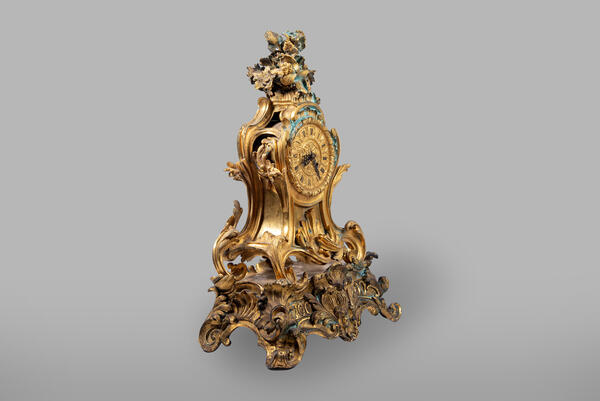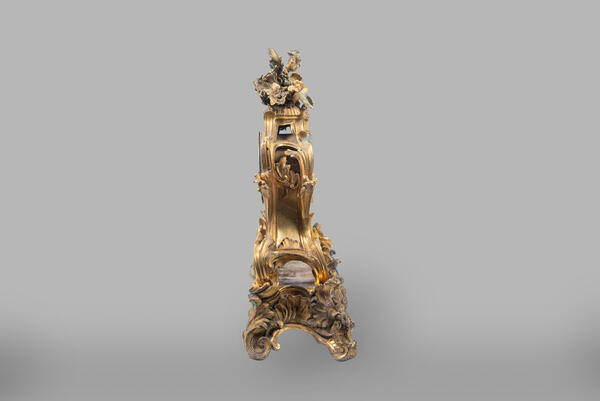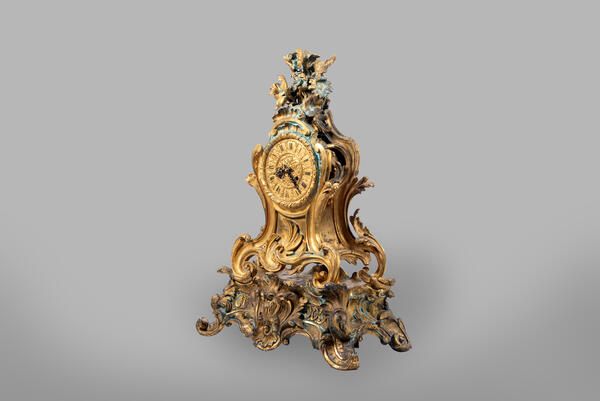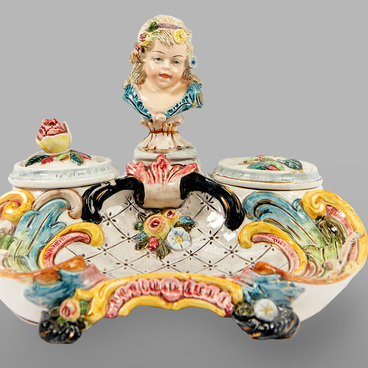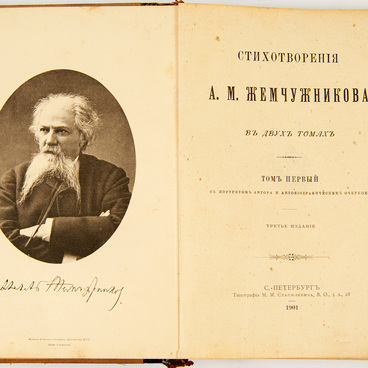Baroque is one of the most ambiguous terms in the history and theory of artistic culture. The word “baroque” refers to an artistic movement, while the same term is used to describe “the last, critical stages in the development of other styles, the tendency towards a restless, romantic outlook and thinking in expressive, unbalanced forms”.
The case of the clock came to the museum together with the furniture from the Obolensky estate; this clock may have stood on the mantelpiece of the manor house of Princes Obolensky in the village of Ira in Kirsanov District. The bronze and gilt case is made in the Baroque style, that is, a whimsical, unusual and inimitable one. The piece is richly decorated with whorls of carved acanthus leaves, garlands of leaves and a bouquet of flowers in the upper part and relief mascarons on the dial. A mascaron is a decorative element, an image of a mask included in an architectural or other spatial environment, on vessels, drawings and patterns.
The fashion for brass and bronze mantel clocks developed in the late Renaissance Baroque period (16th–17th centuries), which originated in Rome and spread further to many Western European countries. Clockmakers paid particular attention to mantel clocks. Only noble and wealthy people commissioned them: the houses of common people or middle class were not equipped with such luxurious fireplaces that they could be furnished with the masterpieces of clockmaking art which the past centuries were rich in. But for the upper classes, the mantel clock was a symbol of status, wealth and competition, so for watchmakers, orders for clock mechanisms of this level were always special. Of course, the mechanism had to be fitted into appropriate cases and the most reputable craftsmen were involved in designing them.
Bronze items have a very long history. They appeared in the 3rd millennium BC in Mesopotamia and Southern Iran. Everything necessary for human life in ancient times was made of this alloy. Archaeologists found weapons (daggers, axes, arrowheads, swords), furniture and interior items (mirrors), and also utensils (jugs, vases, plates) made of bronze. It was also used to make coins and all sorts of jewelry.
Around the 5th–4th centuries BC, ancient Greek sculptors learned how to cast large bronze statues (a technique that is still relevant today, by the way). In the Middle Ages, bronze was used to produce cannons and artillery shells. For a long time, bells were cast from this alloy. By varying the composition and size of the casting, craftsmen created bells with a wonderful sound.
The case of the clock came to the museum together with the furniture from the Obolensky estate; this clock may have stood on the mantelpiece of the manor house of Princes Obolensky in the village of Ira in Kirsanov District. The bronze and gilt case is made in the Baroque style, that is, a whimsical, unusual and inimitable one. The piece is richly decorated with whorls of carved acanthus leaves, garlands of leaves and a bouquet of flowers in the upper part and relief mascarons on the dial. A mascaron is a decorative element, an image of a mask included in an architectural or other spatial environment, on vessels, drawings and patterns.
The fashion for brass and bronze mantel clocks developed in the late Renaissance Baroque period (16th–17th centuries), which originated in Rome and spread further to many Western European countries. Clockmakers paid particular attention to mantel clocks. Only noble and wealthy people commissioned them: the houses of common people or middle class were not equipped with such luxurious fireplaces that they could be furnished with the masterpieces of clockmaking art which the past centuries were rich in. But for the upper classes, the mantel clock was a symbol of status, wealth and competition, so for watchmakers, orders for clock mechanisms of this level were always special. Of course, the mechanism had to be fitted into appropriate cases and the most reputable craftsmen were involved in designing them.
Bronze items have a very long history. They appeared in the 3rd millennium BC in Mesopotamia and Southern Iran. Everything necessary for human life in ancient times was made of this alloy. Archaeologists found weapons (daggers, axes, arrowheads, swords), furniture and interior items (mirrors), and also utensils (jugs, vases, plates) made of bronze. It was also used to make coins and all sorts of jewelry.
Around the 5th–4th centuries BC, ancient Greek sculptors learned how to cast large bronze statues (a technique that is still relevant today, by the way). In the Middle Ages, bronze was used to produce cannons and artillery shells. For a long time, bells were cast from this alloy. By varying the composition and size of the casting, craftsmen created bells with a wonderful sound.

